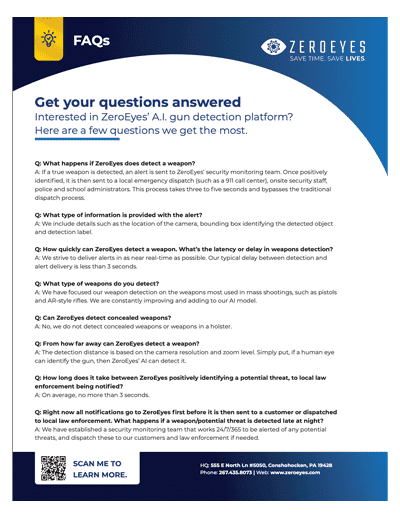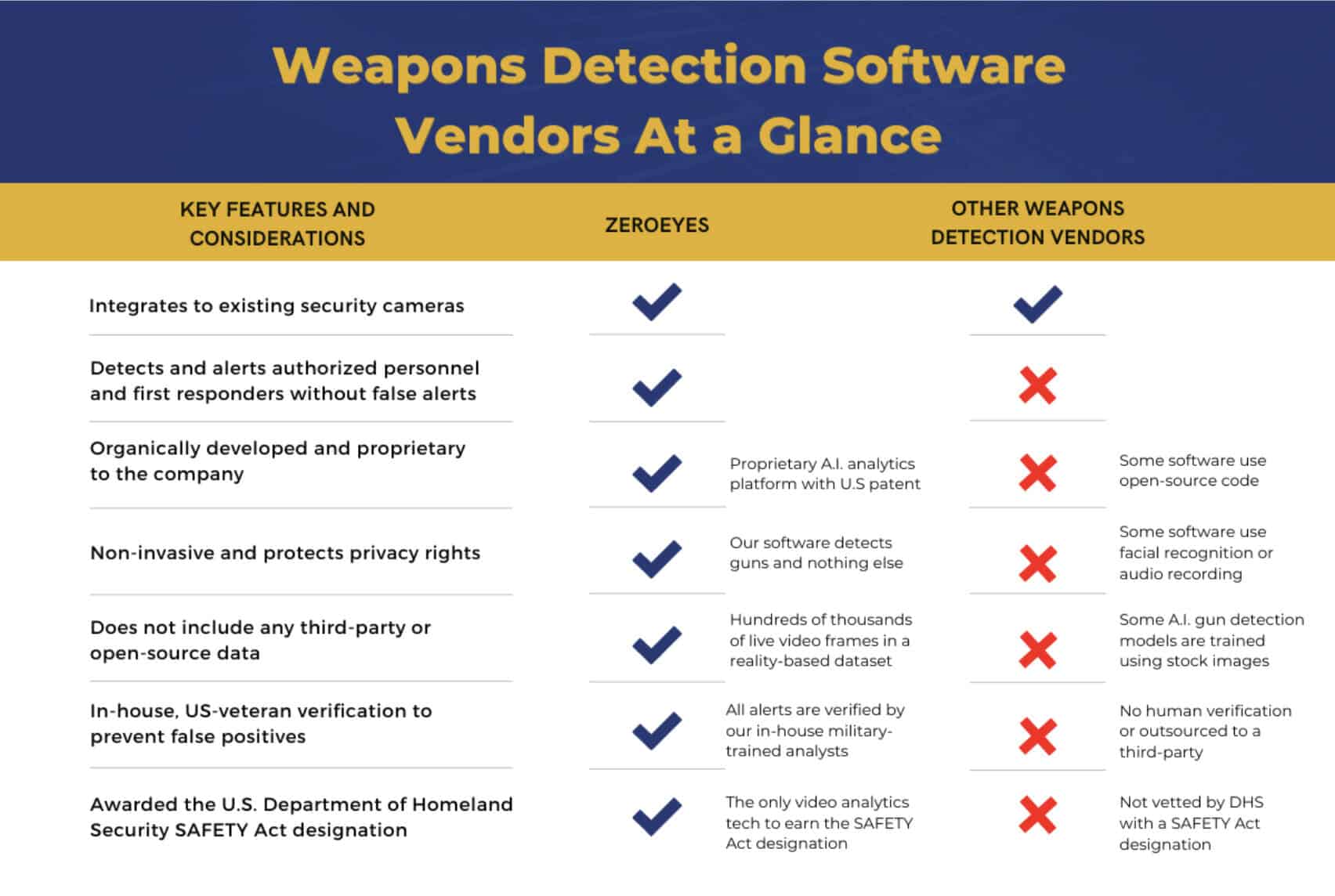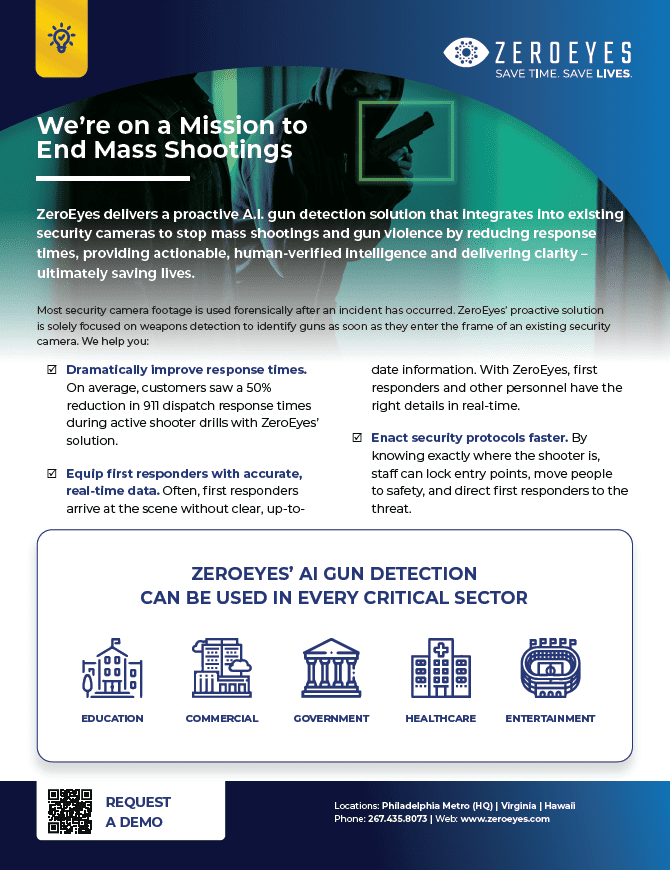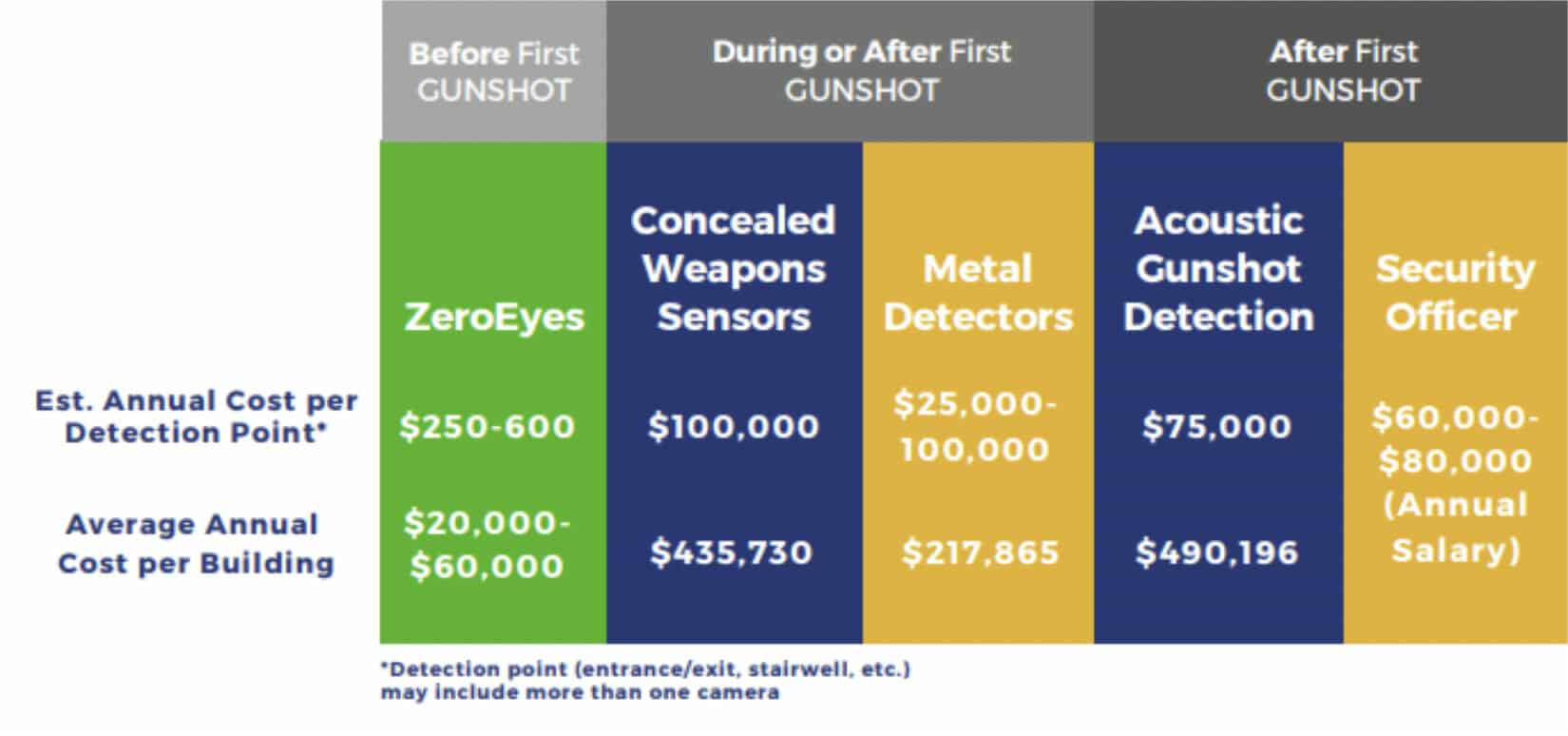
This issue is so prevalent that 76% of Americans say “gun violence” is one of the biggest problems facing the country, superseding concerns of unemployment and the coronavirus outbreak. The pressing question is, what can be done today to protect innocent lives from becoming another active shooter statistic?
Organizations Are Adopting Gunshot and Visual Gun Detection Systems
Organizations are beefing up their security systems and protocols, and are implementing new measures like gunshot detection technology and visual gun detection software.
If you’re new to these terms, “acoustic gunshot detection” and “visual A.I. gun detection” probably sound similar. However, there are striking differences between the two that beget completely different results.
In this article, we’ll break down the differences between acoustic gunshot detection systems and visual A.I. gun detection systems, including the advantages and disadvantages.
What Is Acoustic Gunshot Detection?
Acoustic gunshot detection is a security system that detects, records, and locates the sound of gunfire and alerts the police.
When deployed, acoustic gunshot detection involves a network of acoustic sensors and processing nodes to analyze sounds. These networks can be configured to detect gunshots, explosions, and other heavy weapons discharge, and utilizes acoustic triangulation to determine the location.
In some cases, acoustic gunshot detection can even identify when shots are fired from a moving vehicle and the direction the vehicle is heading, making it a good rapid response and problem-solving tool.
A report by the Illinois Criminal Justice Information Authority (ICJIA) says that when acoustic gunshot detection systems, they saw a 268% increase in police dispatches to “shots fired” calls. This suggests underreporting of gunfire in some areas.
Disadvantages of Acoustic Gunshot Detection
Acoustic gunshot detection can be used as a rapid response tool since it helps alert police of a shooting before 911 calls are made. However, there are several downsides of the technology to consider.
Acoustic Gunshot Detection Is a Reactive, Passive Tool
The first disadvantage to consider is that acoustic gunshot detection is a reactive tool that does not help in preventing gun-related violence from happening. The ICJIA report says that acoustic gunshot detection is “considered passive; it is only applied when an impulsive sound like gunfire occurs.”
A recent study that examined the effect of acoustic gunshot detection in 68 large metros in the U.S. between 1999 to 2016 found that there was no significant impact on firearm-related homicides or arrest outcomes, further supporting that the technology is a reactive tool that does not help prevent gun-related violence.
Live Audio Recordings Present Privacy Concerns
Acoustic gunshot detection systems rely on live microphones in public spaces to capture sound, which raises significant privacy concerns. Voice recordings are a form of personally identifiable information (PII) that the California Consumer Privacy Act (CCPA) and the General Data Protection Regulation (GDPR) protects. Due to the nature of how this security system works, complying with privacy laws can be difficult.
Gunshot Detection Still Has Low Accuracy Rates
Another issue the report discusses is the accuracy rate of acoustic detection. The report cites a 1998 study that said the system accurately identified 72% of shots fired and a 2002 study that reported an 81% accuracy rate for gunshot detections.

False Alerts Create Potential for Dangerous Situations
Although 81% doesn’t sound terrible, a system that dispatches any false alerts wastes law enforcement’s time and can create dangerous situations for both law enforcement and the communities they police.
For more context on how low accuracy rates can create dangerous situations, the American Civil Liberties Union (ACLU) wrote about the problems with the Shotspotter gunshot detection system, which include:
- Sending police into communities with minimal intel. With acoustic gunshot detection, police do not have a description of who they are looking for—they only know the approximate location a potential gun was fired. Unfortunately, this leaves open the potential for racial and other discriminatory targeting.
- Increased tension within communities. When false alerts send police on numerous trips into communities on high alert expecting to confront a dangerous situation, it can create tension between law enforcement and communities. In the city of Chicago, police were sent in more than 60 times a day, and it was found that the “perceived aggregate frequency of ShotSpotter alerts” in some neighborhoods led officers to engage in more stops and pat-downs.
Acoustic Gunshot Detection Is Expensive to Implement
Another area where this technology falls short is the cost of implementation. Gunshot detection systems cost around $65,000-$95,000 per mile of coverage annually.
Factor in the increase in call volumes law enforcement may receive and the low accuracy rates, and you have a very expensive solution. Police agencies, schools, non-profits and other high-risk locations with strapped budgets will have difficulty getting their hands on this technology.
What Is Visual A.I. Gun Detection?
This security method visually detects when a gun becomes visible by leveraging artificial intelligence.
How this generally works is that a security vendor will develop an algorithm that searches for and detects a visual image of a gun. The software is then installed on a facility’s existing digital security cameras to detect when a gun becomes visible and alerts the police.

Have Questions About How ZeroEyes’ Visual A.I. Gun Detection Works?
DOWNLOAD FAQ NOW
What to Look for in Visual A.I. Gun Detection Software
Since visual A.I. gun detection alerts police at the first sight of a gun, not the first shot, it’s an incredibly proactive way to prevent mass shootings—when done correctly.
It’s very important to note that not all visual A.I. gun detection solutions are created equally. For example, some A.I. gun detection vendors train their algorithms with stock images or digital renderings, which aren’t nearly as effective as using a reality-based dataset. This becomes even more problematic if the vendor doesn’t build in a layer of human verification to the process to prevent false alerts.
At ZeroEyes, our algorithm was organically developed using hundreds of thousands of live video frames in a reality-based dataset and is proprietary with a U.S. patent. Since all of our alerts are verified by our in-house military-trained analysts, we can ensure that first responders won’t receive false alerts from our system. These are just a couple of reasons why we are the only video analytics technology of this kind to earn the U.S. Department of Homeland Security’s SAFETY Act designation.
The chart below breaks down some of the major key features and considerations you should think about when assessing a visual A.I. gun detection vendor.


Discover How Proactive Gun Detection Can Prevent Shootings
Download our overview pamphlet to see how ZeroEyes’ proactive A.I. gun detection solution can prevent shootings at schools, workplaces, commercial environments, government facilities, and more.
DOWNLOAD NOW
Acoustic Gunshot Detection vs. Visual Gun Detection: What Is More Effective?
Below are seven major factors to consider when comparing acoustic gunshot detection and visual gun detection. For the sake of brevity, in this comparison, we’ll be using ZeroEyes as the prime example for visual A.I. gun detection.
Reactive vs Proactive Security
- Acoustic Gunshot Detection: Acoustic gunshot detection only works after shots are fired. Since it can only alert the police after the shooting has already happened, it is a reactive security measure.
- ZeroEyes’ Visual A.I. Gun Detection: ZeroEyes’ visual AI gun detection software detects illegally brandished, visible guns the second they appear in the camera’s line of sight, alerting security and first responders before shots are fired.
- Key Takeaway: A strong security system has multiple layers. For instance, door locks in schools are necessary, but would you feel safe knowing that’s the only security at your child’s school? Organizations need to deploy multiple layers of security, and the missing piece that’s crucial to preventing gun-related violence is a proactive layer.
Privacy Concerns
- Acoustic Gunshot Detection: Acoustic gunshot detection uses recorded audio that may include voices and private conversation
- ZeroEyes’ Visual A.I. Gun Detection: Unlike gunshot detection or other visual gun detection solutions, ZeroEyes specializes solely in weapons detection. We never use speech or facial recognition to protect privacy and limit liability.
- Key Takeaway: Organizations need to abide by privacy laws such as CCPA, GDPR and FERPA. It can be a nightmare trying to comply when you deploy security systems that use invasive methods like facial recognition or audio recording. ZeroEyes takes this seriously and it’s why our algorithm was developed to detect images of guns and nothing else.
Location Accuracy
- Acoustic Gunshot Detection: Provides the approximate area of where a gunshot was fired.
- ZeroEyes’ Visual A.I. Gun Detection: Indicates the exact location, thanks to the camera’s geolocation, of where a gun was detected. Since a facility typically has multiple cameras, the solution can continue following the suspect’s movement—providing a trail for law enforcement to work with.
Situational Awareness
- Acoustic Gunshot Detection: Only provides an approximate location of where a gun was shot and does not provide any other details for law enforcement to work with. First responders arrive at the potential scene of a crime without the critical details they need.
- ZeroEyes’ Visual A.I. Gun Detection: Provides exact geolocation, an accurate visual description of the perpetrator, and identification of the type of weapon used.
- Key Takeaway: When first responders arrive at the scene knowing who to look for, what they are armed with, and their most recent location, they can react faster and save lives.
Human Verification
- Acoustic Gunshot Detection: Some systems use humans to verify alerts, which is a very necessary component in these types of solutions. However, sounds can be very difficult to distinguish and determine with 100% accuracy.
- ZeroEyes’ Visual A.I. Gun Detection: Only ZeroEyes’ operations specialists are military-trained for high-pressure situations and can visually verify detections in just 3-5 seconds.
- Key Takeaway: Our human-in-the-loop ensures that law enforcement only receives alerts of illegally brandished guns.
Cost to Implement
- Acoustic Gunshot Detection: The startup hardware costs are significant and the system can cost between $65,000-$95,000 per mile of coverage annually.
- ZeroEyes’ Visual A.I. Gun Detection: ZeroEyes’ A.I. software integrates into existing digital cameras (no need to purchase hardware) and uses high-efficiency/low-cost servers to get up and running. Typically, ZeroEyes’ solution costs less than a few cups of coffee per student, employee, or customer per camera per year.
- Key Takeaway: Although the cost of a solution doesn’t determine whether or not it is effective, this is still an incredibly important consideration point to analyze when comparing the two.

Protect Your People With Proactive A.I. Gun Detection
ZeroEyes’ visual A.I. gun detection is one of the most proactive ways you can prevent gun-related violence, and it can be used in virtually every sector—from schools to healthcare facilities, corporate campuses, and more.
If you’re ready to learn how you can get ZeroEyes at your organization, schedule a free demo here.

